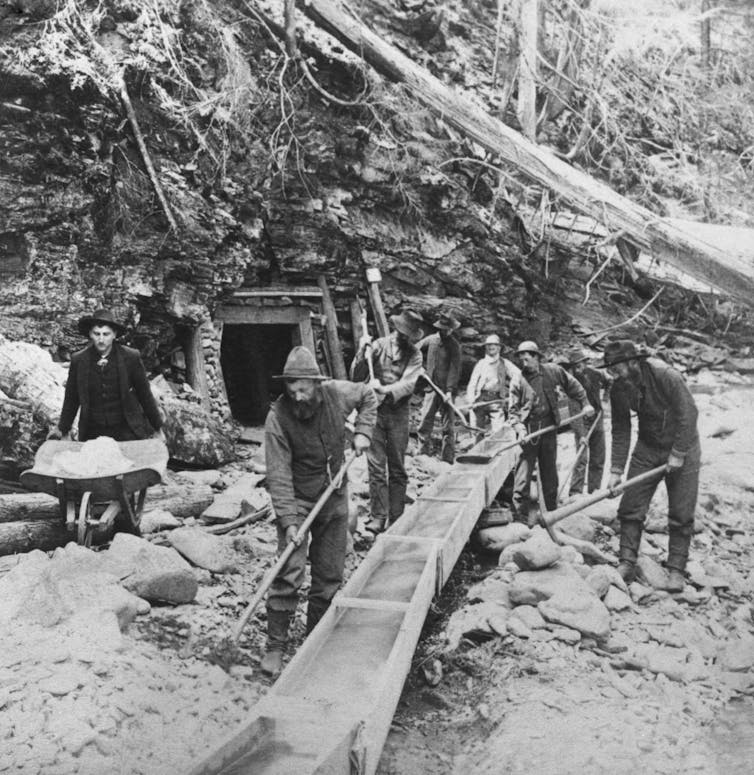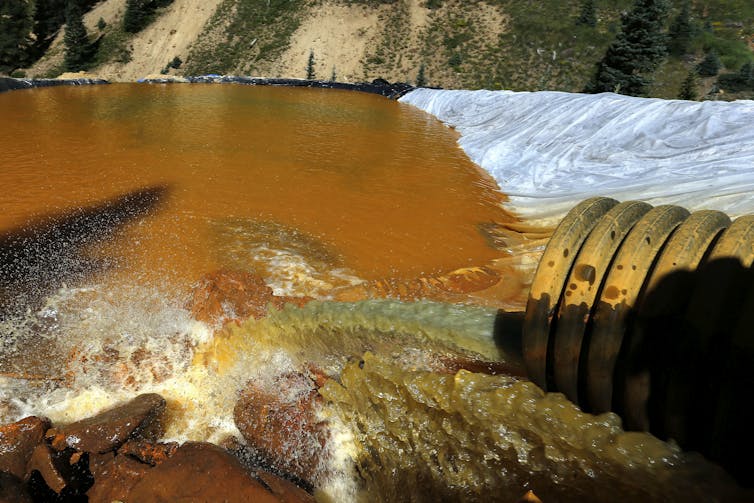Sam Kalen, Associate Dean and Professor of Law, University of Wyoming
When Congress opened U.S. public lands for mining in 1872, the nation was less than a century old. Miners used picks, shovels and pressurized water hoses to pry loose valuable minerals like gold and silver.
Today, mining is a high-technology industry, but it is still governed by the Mining Law of 1872. As was true 150 years ago, companies can mine valuable mineral deposits from federal lands without paying any royalties to the U.S. Treasury.
Even when lands that formerly were available for mining receive new protected status as national parks or monuments, the 1872 mining law protects existing mining claims on those lands. That’s why a company called Energy Fuels Inc. just started mining uranium in January 2024 at a site in Arizona 10 miles from the Grand Canyon and inside a new national monument.

Minerals like lithium, uranium and copper are essential for shifting from fossil fuels to renewable energy, and for many other uses in our increasingly technological society. The Biden administration wants to produce these materials domestically, rather than relying on foreign sources – especially from countries like the Democratic Republic of Congo, where child labor abuses in the mining industry persist.
As a natural resource and public land scholar, I agree with many others who argue that the 1872 mining law is archaic and overdue for an update. It allows the modern mining industry to develop valuable resources on public lands without returning any value to the American taxpayer, and to mine in areas that have sensitive ecosystems or contain important cultural resources for Indigenous peoples.
Royalty-free development
Allowing citizens to enter, explore and ultimately develop claims on federal lands with valuable mineral deposits was part of a broad push to settle the West. Congress enacted the 1872 mining law just a decade after the Homestead Act, which gave settlers up to 160 acres of public land for a small claim fee if they lived on it and farmed it, and three years after the completion of the transcontinental railroad in 1869.
Today, open federal public lands are managed by either the U.S. Forest Service or the Bureau of Land Management. In either case, they are considered available for hard rock mining.
Companies that want to develop coal, oil, natural gas, geothermal energy and solar or wind power on public lands sign leases and pay royalties in return for using these lands to generate private wealth. For example, the current royalty rate for oil and gas production on federal land is 16.67% of the market value of these fuels.
Not so for mining companies, even if they extract precious metals like gold and silver. According to an Interior Department estimate, the value of gold, silver, copper, molybdenum, lead and zinc mined on federal lands in the West in 2019 was approximately US$4.9 billion. If the companies had paid royalties, they would have returned millions of dollars to the U.S. Treasury.
A miner who locates a valuable mineral deposit on public lands and complies with federal and state law enjoys a right to explore and then develop the land, and can even prevent others from doing so. There are two principal qualifying rules.
First, claims can only be located on open public lands that have not been withdrawn from use for other purposes, such as protecting cultural resources or wilderness areas. Second, the 1872 law only applies to valuable mineral deposits, which it defines as those on lands containing locatable minerals that a prudent person would develop because the minerals can be mined and marketed at a profit.
These materials may include precious minerals, such as gold and silver; metallic minerals, such as uranium, lead, copper or zinc; or nonmetallic minerals, such as some types of limestone, bentonite and asbestos. High-profile mining proposals today include copper mines in Arizona and lithium mines in Nevada.Native Americans have fought construction of a lithium mine at Thacker Pass in northern Nevada, which they contend sits on their ancestral land. Environmentalists are divided over the project, which would supply material for advanced batteries.
Decades of debate
Calls for reforming the 1872 law first surfaced in the late 19th century and have persisted ever since.
After all, the law transferred valuable public resources to private hands at virtually no cost, while saddling the public with the resulting environmental burdens, such as ponds contaminated with toxic cyanide. Mining on public lands, especially prior to the 1970s, left a multitude of contaminated zones that federal agencies are still working to clean up at taxpayer expense.
Today, mining operations are subject to modern land management and environmental laws, such as the Clean Water Act. But these laws were not written specifically to address mining and do not fully cover issues such as disposal of mine waste.
University of California legal scholar John Leshy, a former solicitor at the Interior Department and the nation’s premier mining law expert, forcefully described in his 1987 book, “The Mining Law: A Study in Perpetual Motion,” how this statute languished for decades, widely understood as ill-suited to modern times yet eluding reform. Former University of Colorado law professor Charles Wilkinson called the law a “lord of yesterday” in his classic 1992 book, “Crossing the Next Meridian: Land, Water, and the Future of the West.”
Reform advocates support adopting the type of traditional leasing model that is used for most other resources on public lands in the U.S. and elsewhere. As an example, for oil and gas production on federal lands and offshore in federal waters, agencies identify areas with development potential and hold competitive auctions to lease parcels for exploration and development.
Reformists also favor tighter environmental safeguards that would address issues such as management and disposal of mining wastes. Finally, they argue that mining should be prohibited in areas that are ecologically sensitive or are important to Indigenous peoples or tribal nations.

In contrast, the mining industry and its supporters complain that existing laws hinder mining activities. In their view, the federal government applies the 1872 mining law in a way that forces companies to spend years securing necessary approvals. A 2015 report prepared for the mining industry estimated that the average time required to secure all permits for a large mine in the U.S. was seven to 10 years, compared with two years in Canada and Australia.
The industry also contends that imposing a royalty requirement would make it hard for companies to produce critical materials profitably, although these companies currently pay royalties to 12 western states for mining on state land.
In September 2023, the Interior Department released a 168-page report making recommendations for improving mining on public lands. It calls for:
– Putting greater emphasis on environmental protection in mine permitting;
– Preventing mining in areas that are important to tribal nations and Indigenous peoples;
– Replacing the 1872 mining law with a more traditional leasing system that would charge royalties of 4% to 8%; and
– Charging mining companies a fee that would be used to help clean up abandoned mine sites, similar to a fee that coal mining companies have paid since 1977.
Bills are pending now in Congress, introduced by legislators from Nevada, a major mineral-producing state. These measures would retain the structure of the 1872 law while taking steps to streamline permitting for large-scale mining activities.
Balancing critical minerals and conservation
Mining conversations are taking on new urgency as the U.S. pursues a clean energy transition and works to secure essential materials for a modern technology-based economy. In my view, focusing myopically on critical minerals and moving forward with a new era of domestic mining should not occur without reforming the 1872 law.
A rewrite of the law could streamline permitting and create a planning process for mining on public land that mirrors the existing process for energy projects. Halting climate change and powering a new green economy may involve some trade-offs between short-term and long-term environmental protection goals.
But these choices can be made thoughtfully, with a focus on protecting America’s treasured public lands. In 1872, our nation’s lands and natural resources may have seemed inexhaustible; today, we know they are finite, and that using them responsibly means balancing development and stewardship.
This article is republished from The Conversation under a Creative Commons license. Read the original article.






